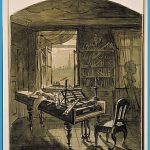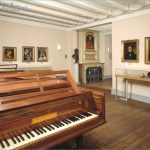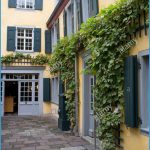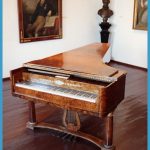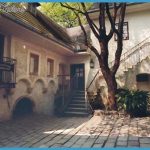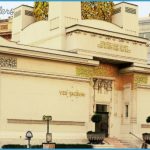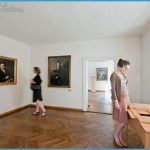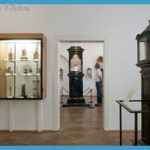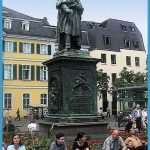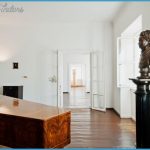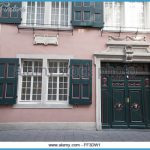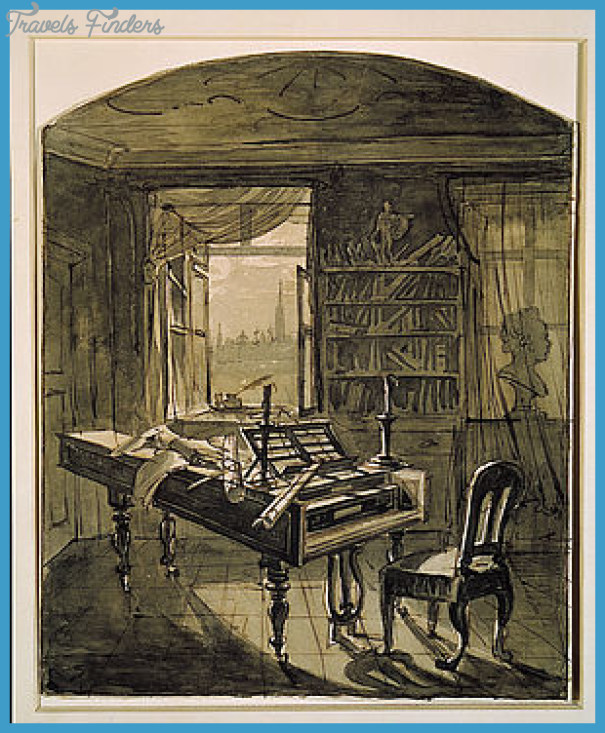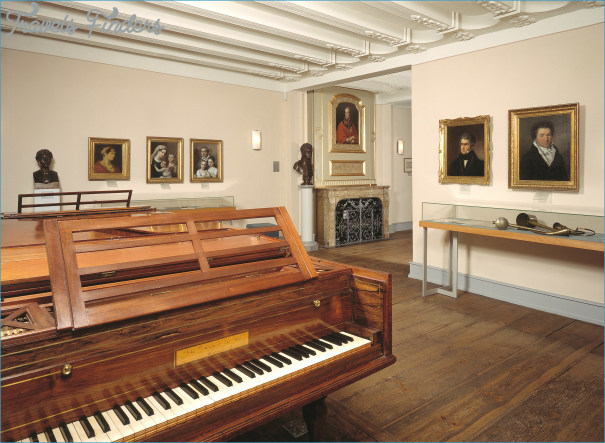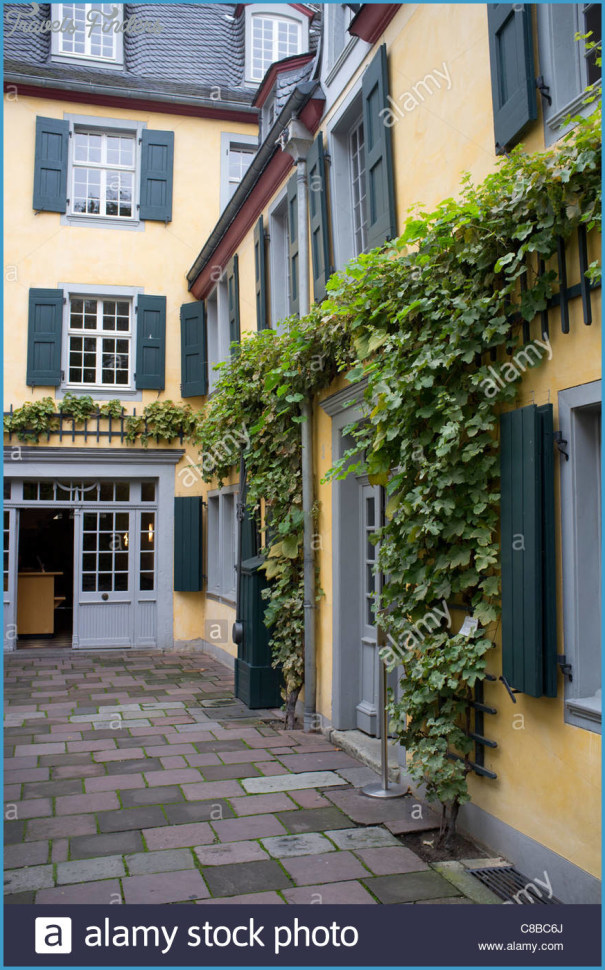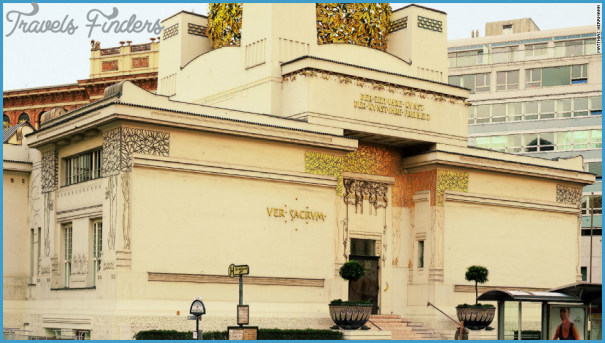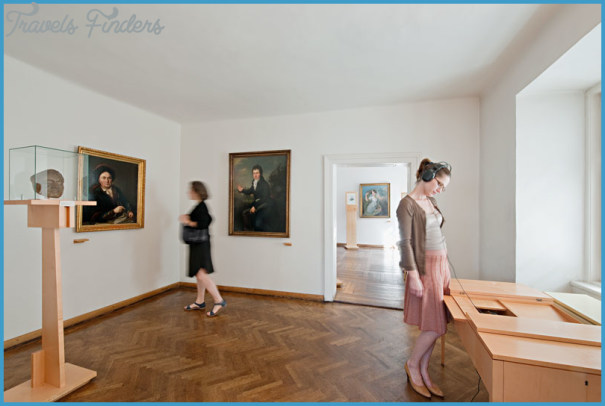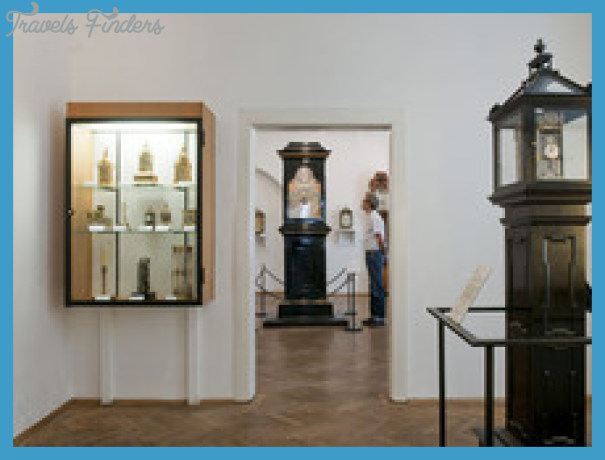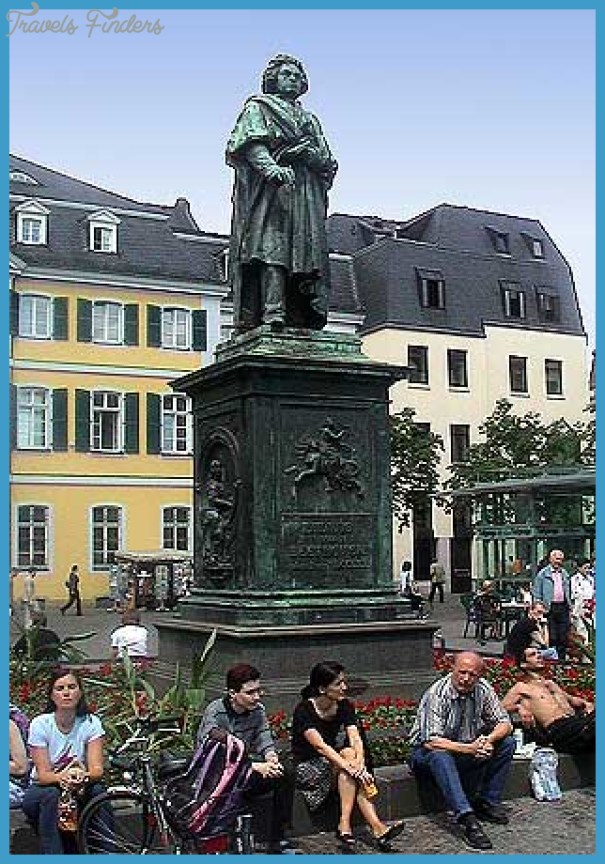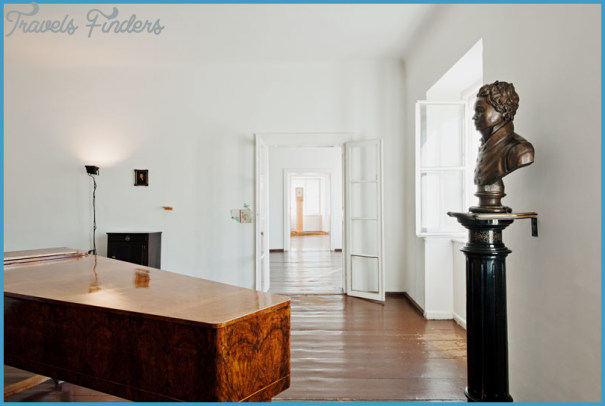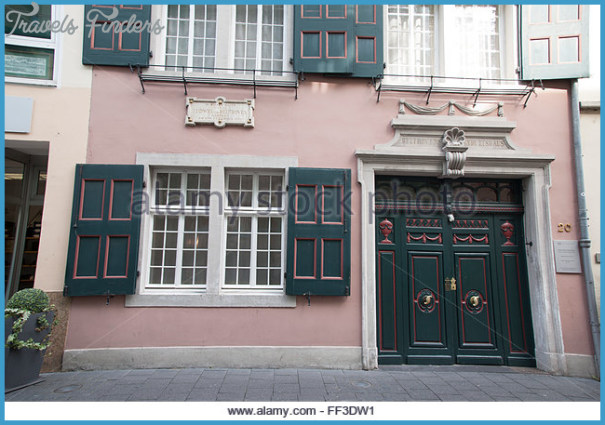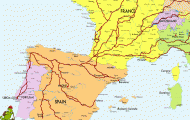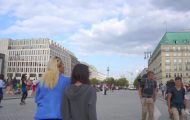No composer is better served by museums than Beethoven. That is not surprising: almost universally seen as the greatest of the great during most of the 19th century and the first half of the 20th, and having slept in almost as many houses in central Europe as Queen Elizabeth did in England, he is clearly a strong candidate for widespread commemoration. There are in fact no fewer than 12 museums or memorial sites to Beethoven, in five countries.
One of them is not exactly a museum to Beethoven: it is a museum to his mother. Maria Magdalena van Beethoven was born, in 1746, as Maria Magdalena Keverich, in the small town of Ehrenbreitstein, just across the Rhine from Koblenz. Daughter of the kitchen overseer at the castle of the Elector of Trier, which towers over Ehrenbreitstein, she was married in 1763 to a valet to the elector, and widowed two years later, having lost her only child. In 1767 she was married again, to Johann van Beethoven, a musician at the electoral court at Bonn; three of their children survived infancy, Ludwig, Caspar and Johann. She died in 1787. Her brother was prior at the nearby Carmelite monastery.
BEETHOVEN MUSEUMS Photo Gallery
The house is by no means exactly as it was in her time. It dates from the early 17th century and was rebuilt after the 30 Years War. Maria’s father took it in 1730 and her mother sold it after Maria’s marriage. Various changes were made in the 18th century. It was acquired by the City of Koblenz at the end of the 1960s and restored, with help from the Land Rheinland-Pfalz and the Deinhard Foundation, and opened in 1975. In 1984 it was severely damaged during a fire in a neighbouring house and was largely rebuilt, incorporating however the original 18th-century newel and spiral staircases at the front and the rear respectively. It reopened in 1989.
Beethoven’s links with Ehrenbreitstein were not confined to his mother. By a curious coincidence, the family of his friend Franz Wegeler is now involved with the Deinhard wine firm, and through this connection the museum has some of their correspondence and music and also some illustrative material. A Keverich room is devoted primarily to Maria’s family, a Beethoven room to materials linked with the composer, including a square piano of the period and the Wegeler family’s treasure box for their Beethoven items. There is a further room, furnished in Biedermeier style, with a variety of portraits and showcases with letters and music. Further Beethoven connections with Ehrenbreitstein, through acquaintances who were born or lived there, are also commemorated. The displays are chiefly in the rooms on the first floor ; on the top floor there is a recital hall which can seat 100.
It is symptomatic of the centrality of Beethoven that when in 1889 a dozen Bonn worthies, determining to save the house of his birth from demolition, set up the Verein Beethoven-Haus, they took only a year to raise the funds to buy the property, rehouse the 60 people then living in it, restore it and open it as a museum. Some 50 years before, Franz Liszt had abandoned his retirement from the concert platform to help support the committee planning to erect a Beethoven statue in Bonn ; this time, to meet the running costs, Joseph Joachim initiated a series of five-day chamber music festivals, held eight times over the ensuing years.
The house into which Johann van Beethoven and Maria Magdalena moved, in 1767, was at the rear of the present Beethoven-Haus, which is in fact a combination of two houses. The buildings date back to the beginning of the 18th century, when Bonn was substantially reconstructed after a siege in 1689, although the foundations are much older. The Beethovens occupied four rooms in the smaller house, on the first and second floors; they moved out in 1774, as the family grew. None of their other homes in Bonn survives.
Beethoven’s birthplace in Bonn and some of the walls between the houses were removed. The buildings underwent structural repairs in the 1930s, with further renovations in 1968-9 and the mid-1990s. The Beethoven archive established at the time of the centenary in 1927 was moved from the neighbouring house to Bonngasse 24-6, which is now the leading institute for research, documentation and publishing on Beethoven. A foyer links the buildings at the rear. There is an impressive semicircular chamber-music hall, seating 199, of wood, leather and marble. Immediately below the platform is the vault in which some two-thirds of Beethoven’s autograph manuscripts are carefully and securely stored.
The Beethoven-Haus has the enormous advantage of being able to draw on its archives for its displays and its shortterm exhibitions, as well as the support of ample scholarly resources – although, in tune with modern conservation policies, originals are only occasionally displayed and high-quality facsimiles are normally used. Entry is at the museum shop: on the ground floor are three rooms, one with its walls lined with pictures of performers who have played in the house, the next with a display of programmes and publications, the third with a Beethoven genealogy and maps of the city. The main display, upstairs, is probably the richest and most comprehensive of all those described in this book.
The first room, the ‘Bonn Room’, has portraits of Beethoven’s grandfather, the court Kapellmeister, his teacher C.G. Neefe, the tenor Anton Raaff and the violinist J.P. Salomon, and a display case shows Beethoven’s earliest music publication, of 1782. There are also prints of views in Bonn. The next room is concerned with the family background, of his paternal grandfather in Mechelen and his mother, and contains Beethoven’s baptismal entry; the third deals with Beethoven’s youth and his friends, among them the Wegelers, the Breunings and the Ries family, all of whom played significant roles in his later life. The other, larger rooms and the hallway that separates them belong to the Bonngasse house. Of these the first is dominated by the console of the organ from the Minorite church, on which Beethoven played as a boy, and his own viola, which he played in the court orchestra; there are also portraits of two electors, as well as music and letters. The earliest representation of Beethoven in this room, a silhouette drawn when he was 16, can be contrasted with the powerful bronze bust by Franz Klein, made from a life-mask when he was 42, in the hallway. There are more images in the front room, a copy of the Mahler painting of 1815 and the Schimon of 1818-19. The five showcases here are used for changing exhibitions, largely of music autographs, including sketchbooks, and letters, complemented by a cabinet with the writing tools from Beethoven’s desk. The busts include one of his pupil
Giulietta Guicciardi, dedicatee of the ‘Moonlight Sonata.
On the upper floor the two large rooms are devoted to Beethoven’s life in Vienna. The 1823 Graf piano, Beethoven’s last, is the only one of the several early pianos in the museum that actually belonged to him. A string quartet of instruments, given to him by Prince Lichnowsky, is preserved in a glass case. There are oil portraits of the Brentano and Brunsvik families, along with miniatures that once belonged to Beethoven of family members; there is also an oil of Archduke Rudolph, in his archiepiscopal finery, and the Stieler and Waldmuller Beethoven portraits. Poignantly, four of his ear-trumpets are shown, with a facsimile of the famous ‘testament about his deafness written at Heiligenstadt. There are other personal objects, his glasses, some seals, bookends and an inkwell, a clock, a razor, a walking stick, locks of hair; some of these are from the Bodmer collection, which also includes numerous letters and autograph music, bequeathed to the Beethoven-Haus in 1959 and not regularly on display. One corner is devoted to Beethoven’s death, his will and his funeral and interment. The juxtaposition of the 1812 life mask with his death mask speaks eloquently of his suffering in those late years.
In 1792 Beethoven moved to Vienna. During his early years in the city he sometimes stayed in a patron’s house as a guest. Later he took apartments of his own, but he rarely stayed in one for long: one authority lists 87 moves, including his sallies out of Vienna to escape the heat and the noise of the city – and there are periods on which we have no information. Some degree of mobility was usual, particularly for a man living alone, but Beethoven was a restless spirit and a difficult and demanding tenant and his record must be exceptional. There were times when he held leases on two, even three or four, flats simultaneously. Accordingly, Vienna and the surrounding districts are bespattered with houses lived in or visited by Beethoven, and many of those that survive bear plaques recalling the connection. Within the present city itself, four of his former residences are designated as memorial sites or museums.
Of these the first, in the chronology of Beethoven’s life, is the house in Heiligenstadt, where he stayed during the summer of 1802, probably from about May until October, the time of the composition of the Second Symphony. Heiligenstadt, four kilometres north of the centre of the city, and even now a pleasantly leafy suburb, was wholly rural, a wine-making village and a spa whose waters, Beethoven’s doctor vainly hoped, might improve his hearing. This was the time when Beethoven came to terms with his encroaching deafness, as is shown by the Heiligenstadt Testament -the remarkable, anguished document in which he described the effect on him of his affliction, and whose writing seems to have been a conscious and in the event successful attempt to face and exorcise his despair and rally his determination to fight back.
The memorial house at Probusgasse 6 – there can be no certainty that this is the actual house in which Beethoven stayed: the only ‘evidence is anecdotal, and based on a presumption made in 1902 -dates back to the 16th century. In 1970 the house, with its attractive inner courtyard, was restored to something close to its condition in 1800, although the wooden balcony at the rear is an addition of the 1930s. The Vienna Beethoven Society, founded in 1954, has its offices in the front wing, with a separate exhibition devoted to Beethoven’s relationship with the Heiligenstadt and Unterdobling areas: there are several contemporary views and facsimiles of letters and works written there or referring to his time there.
Two spacious rooms are given over to displays. As one of the official City of Vienna museums, it follows in its general design a standardized pattern, with much use of polished, stained wood, vertical stands for exhibits, hinged covers and pull-down captions.
Courtyard of Probusgasse 6, Heiligenstadt plates from his last apartment.
Beethoven returned several times to Heiligenstadt, in 1807, 1808 and 1817: the houses in which he is believed to have stayed on the last two visits, GrinzingerstraBe 64 and Pfarrplatz 2, are both marked by plaques. There is also a statue to him, erected in 1910, on the east side of the park off GrinzingerstraBe, and a bust, the earliest to him in Vienna, dating from 1863, in the Beethovengang in Kahlenberger StraBe. The finest Beethoven statue in the city, however, is the 1880 one by Caspar Zumbusch in the Beethovenplatz, near the Konzerthaus.
The area north of Vienna was one that Beethoven favoured for his summer homes. Just south of Heiligenstadt lies Unterdobling, and south of that is Oberdobling. On one of the main roads from Heiligenstadt to central Vienna lies the Eroica-Haus, Doblinger HauptstraBe 92. Now a busy suburban thoroughfare, the Doblinger HauptstraBe was a country lane through a wine-growing area when Beethoven stayed there, probably in the summer of 1803, when he was at work on the ‘Eroica Symphony, and possibly for a brief spell late in the following summer. Most Beethoven scholars believe that the actual house he lived in no longer stands, but at least this one lies close by. Since Beethoven’s day it has been extended and a second storey was added to part of it in about 1840. It is entered through a courtyard. There are three display rooms, rather austerely set out. Two show contemporary watercolours and prints of Dobling. One has a portrait of Gellert and reproductions of music from the time, among them the recent Gellert settings, the Waldstein Sonata, the Triple Concerto and Christus am Olberge; the other is the Eroica Room, with Napoleon and Prince Lobkowitz, and a print of the Theater an der Wien, where Beethoven currently had use of an apartment. The third room has a single display case with three prints. Another of Beethoven’s residences in Dobling, at Silbergasse 4, is commemorated with a plaque, but the actual building in which Beethoven stayed in 1815 no longer stands.
The third of the City of Vienna museums is in the Pasqualati-Haus, Molkerbastei 8, on the north-west edge of the central first district. This is a large block of flats, built at the end of the 18th century by the family of a friend and admirer of Beethoven, a nobleman, property developer and composer, Baron Johann Baptist von Pasqualati, who owned a part of it. Beethoven moved there, probably from Dobling, in September 1804, and it was his main residence until the middle of 1808 ; he returned briefly the following spring, then again in 1810, where it served as his main home until early in 1814. He then briefly occupied an apartment in the neighbouring house, Molkerbastei 10, but was back again at the end of 1814, leaving finally in spring 1815. Most of his great middle-period works were composed here.
Once again, it is impossible to be certain which flat he lived in; he may have had different ones at different times. Some callers talk of visiting him on the third floor, some on the fourth, but the consensus today is that it was truly the fourth, and descriptions of his situation and his view suggest that it was at the east end of the building.
The memorial rooms are probably not in Beethoven’s actual apartment but as the Viennese museums do not seek to recreate his living environment that is of less consequence. The display, then, is focussed on his middle period. An ante- room is devoted to ‘Genius loci’, with the architectural plan of Molkerbastei 8. The first room has various personal relics: a small cabinet, a clock, and Beethoven’s sugar-bowl and salt and pepper holders, as well as a Streicher piano and the stern bust of him by Franz Klein. In the next is a large display focussing on the city of Vienna and on Beethoven’s middle-period works: Fidelio, with the music itself, the librettists, the singers, the performances; Count Razumovsky and his quartets; and the symphonies from no.4 to no.8 and the Battle ofVittoria. A third has the original oil portraits of Beethoven’s grandfather and Beethoven himself by Mahler, as well as the Klein life mask; and in the last are portraits of many of Beethoven’s acquaintances -the Breunings, the violinist Ignaz Schuppanzigh, the publisher Artaria, members of the Brunsvik, Lobkowitz and Lichnowsky families and Bettina von Brentano. As in several museums of this group, there is a listening console.
Most of the Viennese Beethoven museums, like this one, have pianos of the kinds he used. But the enthusiast in this direction would do best to visit the Kunsthistorisches Museum, whose Sammlung alter Musikinstrumente is arranged chronologically, with reference to Viennese composers; Room XIV, the Beethoven Room, ranges from a Walter piano of 1790 to a Graf of about 1820, with several in between, and busts or portraits of some of the leading Viennese makers.
The common management of the Viennese municipal composer museums, and the unity of style imposed upon them by the decision to redesign them all in the 1990s, precludes any attempt to create atmosphere specific to any of the composers or indeed any particular period. One might have wished for more expenditure of historical imagination. Perhaps Beethoven suffers from this more than most of the others as his reported way of life relates uncertainly to the crisp tidiness of the Viennese museum livery. The city possesses a great deal of
Beethoven material, which is divided between the several houses; but it is nowhere made clear to the visitor that there is at best a considerable degree of uncertainty as to whether the master actually lived at any of the three Gedenkstatte.
Still within Vienna today, in the Floridsdorf district across the Danube to the north-east of the city, is the modest country seat of the Erdody family, built in a large park in 1795 in the village of Jedlesee by Count Peter and Countess Anna Maria Erdody. The Countess was a patron, admirer and friend of Beethoven’s; he dedicated his two piano trios op.70 and two cello sonatas op.102 to her. There is no firm evidence as to when he visited her country house; it was reasonably close to Heiligenstadt and Dobling and he may well have done so from there. We do know that he was her guest at her house in KrugerstraBe, in central Vienna, for several months in 1808-9. He may have been to Jedlesee as early as 1802, or around the time he was in KrugerstraBe; they quarrelled in 1809 and were reconciled in 1815.
A small display in the house, inaugurated in 1973, celebrates the connection. A pair of rooms, with appropriate portraits looking down on proceedings, also serves as a recital hall, seating about 70. There is further pictorial matter, and Biedermeier furniture, in the meetings room. A bust of Countess Erdody surveys the reception area. The collection is modest, but it includes a Beethoven autograph, letters of the Countess, a lock of hair thought to be Beethoven’s and other documents and notebooks. A stable wing, burnt down in 1863, has been reconstructed to serve as a small museum of the house’s history.
This is not the only instance of a shortage of precise information about Beethoven’s visits to his friends. A family with which he was deeply entangled over many years was the Brunsviks, whose daughters Therese and Josephine were his pupils; at one time he nurtured hopes of marriage with Josephine, who some scholars believe is the ‘Eternally Beloved of the famous letter. Their mother had bought Beethoven’s op.1 piano trios by subscription in 1795, but probably Beethoven did not meet them until 1799. The family had country homes in Hungary, at Martonvasar, 20 km south-west of Budapest, on the main road between the capital and Lake Balaton, and at Korompa.
Beethoven is known to have visited Hungary several times, first in 1796, then in 1800, when he spent some time in Budapest, and possibly in 1806 and 1809.
The Brunsvik home at Martonvasar
The only documentary proof that he ever visited the family there comes from remarks by Therese Brunsvik and a reminiscence of his pupil Carl Czerny. The Brunsviks country house, standing in a large park with fine rows of chestnuts, was built in the 1780s and added to in the 19th century. It became a Beethoven museum in 1958. Four rooms, one of them used for a video installation, are assigned to Beethoven. The displays, attractive and spacious, focus on the Brunsvik family and Beethoven’s Hungarian connections, with portraits and drawings, copies or facsimiles of music and letters and other Brunsvik family papers, collections of books from the family library and early editions of Beethoven works.
The Brunsviks other country house is at Dolna Krupa, a small town about 50 km north-east of Bratislava and about 15 km north of Trnava: a large palace, in imperial yellow, in extensive grounds with a lake and woods. Again, there is no certainty about Beethoven’s visits, but again it seems probable that he would have been there at some point. At any rate, the charming little lodge to the left of the main building is kept as a memorial to him. In the ground-floor room facing the park is a bust, a square piano, a writing Beethoven memorial rooms at Dolna Krupa desk and various facsimiles, with a Brunsvik family tree, and in the small dining-room is an inlaid table and chairs along with reproduced portraits of Beethoven and the Brunsviks. Up a spiral staircase are two more rooms, one for listening, the other, rather sparse, but with a display of relevant facsimile material.
We do know rather more about Beethoven’s visits to another patron’s castle – that of Prince Lichnowsky at Hradec nad Moravia, eight kilometres south of Opava in northern Moravia, on the edge of Silesia. He was Lichnowsky’s guest in the autumn of 1806 and, briefly, in the late summer of 1811. It was on the first visit that one of the more colourful anecdotes about Beethoven was generated, the tale of his walking out and, in a thunderstorm, returning to Vienna in a rage, when asked to perform for visitors ; the tale is borne out by the smudged autograph score of the ‘Appassionata Sonata, which he was composing and carrying at the time.
The castle itself was built in 1797, when an older one had burnt down, in a neo-classical Empire style, and underwent various modifications in the 19th century. It had belonged to the Lichnowskys since 1778. It is now open to the public as a general historical museum with, on the first floor, a Beethoven memorial room. In it is the Erard piano of 1803, built for Lichnowsky, on which presumably Beethoven played, a music desk that he is said to have used, a set of string quartet instruments, and early Viennese furniture; on display are facsimiles of various Beethoven works with Lichnowsky connections, and a plaque put up in 1909 to commemorate his visits. A vaulted side room, off the main exhibition, has photos of recent Lichnowskys and paintings by some of them, letters on musical topics and the local countryside.
In his later years, Beethoven often favoured the country areas south of Vienna, rather more distant from the centre, for his ‘Sommerfrische journeys. He paid his first, brief visit to Modling, about 17 km to the south-west, in 1799, then went there for longer spells – generally May or June to September or October – for three years, 1818, 1819 and 1820. He liked the countryside there, with its romantic landscapes – in a letter of the time he refers to ‘roaming the mountains, the ravines and the valleys with music-paper in my hand – but for much of the time he was in the grip of anxieties about his nephew who was in his care, and sometimes so foul-tempered that his servants walked out. Nevertheless, in the Modling months he worked on such music as the Hammerklavier Sonata, the Missa Solemnis and the Diabelli Variations. In some of these summers, he actually moved in, bringing his furniture from Vienna; and it was in Modling that he received the gift of a six-octave Broadwood piano from London.
In 1819, and probably also the preceding year, he lived in the ‘Hafnerhaus’, a former pottery workshop; he had a suite on the first floor, an anteroom and a pair of rooms linked by an archway. The acoustical properties afforded by the vaulted ceilings would, alas!, have been lost on him by this date. The building now belongs to the municipality and in 1970 the rooms he occupied were dedicated as a memorial. Their austerity is relieved by a few items of furniture of the period, among them a Viennese grand piano of 1794, some reproductions of prints of Modling and three display cases, with facsimiles of relevant material. There is also a bust and a death mask. The house where Beethoven stayed in 1820, the Christhof, is nearby.
A further 15 km in the same direction from Vienna lies the larger, more fashion Beethoven’s rooms in the Hafnerhaus at Modling able spa of Baden, another of Beethoven’s favourite watering-places. He had paid brief visits to friends there as early as 1803-4, then had visited the town almost every summer from 1807 to 1816, for anything between a few days and three or four months. After his flirtation with Modling, he reverted to Baden and spent time there, sometimes going on after a spell in Dobling, each year from 1821 to 1825. Two of his favourite lodgings were the Johanneshof, in Johannesgasse, and the Alter Sauerhof, in WeilburgstraBe, neither of which still stands. But in 1821 and 1823 he stayed in the Rathausgasse, at the present no. 10, on the corner of what is now Beethovengasse. He may have been there briefly in 1822, but he also stayed at two other addresses, and there is a plaque outside the former Zur goldenen Schwan stating that he composed the Consecration of the House overture there. The building in Rathausgasse, on two storeys, was acquired by the municipality in 1962 and a museum was established in the first-floor rooms that Beethoven occupied. The building is called the ‘Haus der Neunten’, as he worked on the Ninth Symphony there in 1823. On his first visit he worked on the Missa Solemnis. There is a small anteroom and a spacious principal room, with display cases showing relevant facsimiles and pictorial items, as well as a survey of Beethoven’s sojourns in Baden and his various homes in the town. There is a particularly interesting account book from a Baden inn. In Beethoven’s bedroom there is period furniture as well as display material, with elegantly presented portraits of his contemporaries. A large alcove off this room is used for temporary exhibitions on musical topics unrelated to Beethoven but germane to Baden’s musical history.
Beethoven visited Baden twice more in the following years, staying at the SchloB Gutenbrunn. In 1826 he remained in Vienna until September, when he at last accepted his brother Johann’s invitation to visit the summer estate and vineyards, covering about 1.5 sq. km, that he had acquired in 1819 at Gneixendorf, a village just north of Krems. Beethoven and his nephew Karl arrived there, to stay two weeks, but remained until the beginning of December, when they left in a hurry after the brothers quarrelled about Karl. The rest of the story is well known: Beethoven and Karl, hurrying to get back to Vienna, travelled in an open milk-wagon; cold and wet, Beethoven contracted pneumonia and died the following March.
The Gneixendorf properties have been owned since 1867 by the Gettinger family, who continue the tradition of winemaking on the estate, which had originally been owned by a monastery and was secularized in 1806. Beethoven and Karl stayed not in the main house, the Wasserhof, but Beethoven’s brother’s house at Gneixendorf in another close by, the Trautingerhof, where they occupied the first floor; here Beethoven completed the op. 135 string quartet, wrote the new finale for the op. 130 one, and began work on a string quintet op. 137. The Gettingers have set these rooms aside as a memorial to Beethoven. There is a small anteroom off the landing, where there are facsimiles of some letters and a sketchbook, then a large central room, notable for its striking murals, a series of slightly faded, delicately romantic, early 19th-century landscapes, presented as if seen from a loggia, and signed Friedrich Wilhelm Reinhold. Frau Gettinger believes these have stood unchanged since Beethoven’s time. This central room certainlyhas its original floors and doors; there is a bust of the great man, a grand piano, and some furniture, made by earlier Gettingers, dating back to the 19th century. One side is a dining-room, furnished with family pieces, and there is a bedroom, with a large bed between two pillars. The property has undergone various vicissitudes: it was a Nazi prisoner-of-war camp for a time after 1939, then a typhus hospital, and from 1945 the Russians occupied the estate for two years. But enough seems to have survived to make it a moving memorial to Beethoven’s last months.

